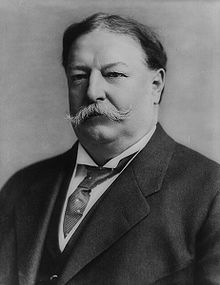William Howard Taft (September 15, 1857 – March 8, 1930) was the 27th President of the United States (1909–1913) and later the tenth Chief Justice of the United States (1921–1930). He is the only person to have served in both offices, and along with James Polk, one of two presidents to have also headed another branch of the federal government.
Before becoming President, Taft was selected to serve on the Ohio Superior Court in 1887. In 1890, Taft was appointed Solicitor General of the United States and in 1891 a judge on the United States Court of Appeals for the Sixth Circuit. In 1900, President William McKinley appointed Taft Governor-General of the Philippines. In 1904, President Theodore Roosevelt appointed Taft Secretary of War in an effort to groom Taft, then his close political ally, into his handpicked presidential successor. Taft assumed a prominent role in problem solving, assuming on some occasions the role of acting Secretary of State, while declining repeated offers from Roosevelt to serve on the Supreme Court.
Riding a wave of popular support for fellow Republican Roosevelt, Taft won an easy victory in his 1908 bid for the presidency.
In his only term, Taft’s domestic agenda emphasized trust-busting, civil service reform, strengthening the Interstate Commerce Commission, improving the performance of the postal service, and passage of the Sixteenth Amendment. Abroad, Taft sought to further the economic development of nations in Latin America and Asia through “Dollar Diplomacy”, and showed masterful decisiveness and restraint in response to revolution in Mexico. The task oriented Taft was oblivious to the political ramifications of his decisions, often alienated his own key constituencies, and was overwhelmingly defeated in his bid for a second term in the presidential election of 1912. In the historical rankings of Presidents of the United States, Taft receives an aggregate ranking of 22nd.
After leaving office, Taft spent his time in academia, arbitration, and the search for world peace through his self-founded League to Enforce Peace. In 1921, after the First World War, President Warren G. Harding appointed Taft Chief Justice of the United States. Taft served in this capacity until shortly before his death in 1930. He is the only former president to administer the oath of office to another President and the only Chief Justice to serve with associate justices whom he had appointed to the court.
In 1904, Roosevelt appointed Taft as Secretary of War. This appointment allowed Taft to remain involved in the Philippines and Roosevelt also assured Taft he would support his later appointment to the Court, while Taft agreed to support Roosevelt in the Presidential election of 1904. Roosevelt made the basic policy decisions regarding military affairs, using Taft as a well-traveled spokesman who campaigned for Roosevelt’s reelection in 1904. Of Taft’s appointment, Roosevelt said, “If only there were three of you; I could appoint one of you to the Court, one to the War Department and one to the Philippines.” Taft met with the Emperor of Japan who alerted him of the probability of war with Russia. In 1905, Taft met with Japanese Prime Minister Katsura Tarō. At that meeting, the two signed a secret diplomatic memorandum now called the Taft–Katsura Agreement. Contrary to rumor, the memorandum did not establish any new policies but instead repeated the public positions of both nations.
In 1906, President Roosevelt sent troops to restore order in Cuba during the revolt led by General Enrique Loynaz del Castillo, and Taft temporarily became the Civil Governor of Cuba, personally negotiating with Castillo for a peaceful end to the revolt. Also in that year Roosevelt made his third offer to Taft of a position on the Court which he again declined out of a sense of duty to resolve pending issues in the Philippines. Had it been for the Chief Justice seat, a different result may well have ensued.
Taft retired as Chief Justice on February 3, 1930 because of ill health. Charles Evans Hughes, whom he had appointed to the Court while president, succeeded him.
Five weeks following his retirement, Taft died on March 8, 1930, the same date as Associate Justice Edward Terry Sanford (who died unexpectedly). As it was customary for members of the court to attend the funeral of deceased members, this posed a “logistical nightmare”, necessitating cross-country travel.
Sources: Wiki/InternetPhoto/TheCubanHistory.com
MilitaryOccupation:William Taft/The Cuban History/ Arnoldo Varona, Editor



 Military Occupation: William Taft
Military Occupation: William Taft